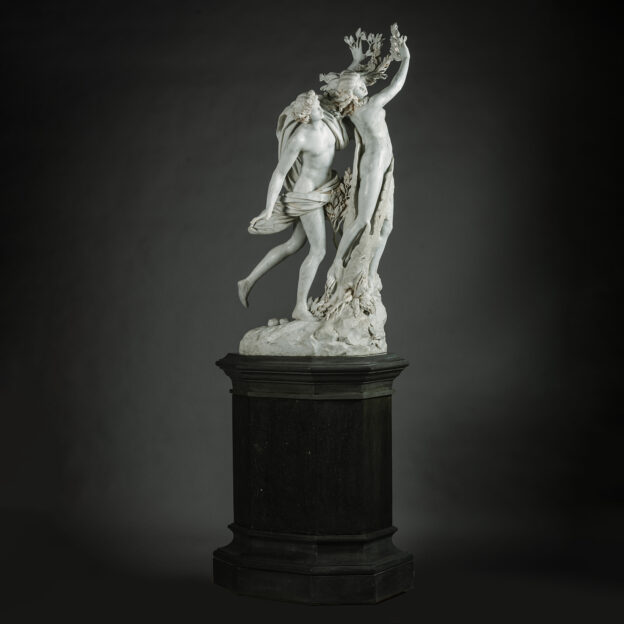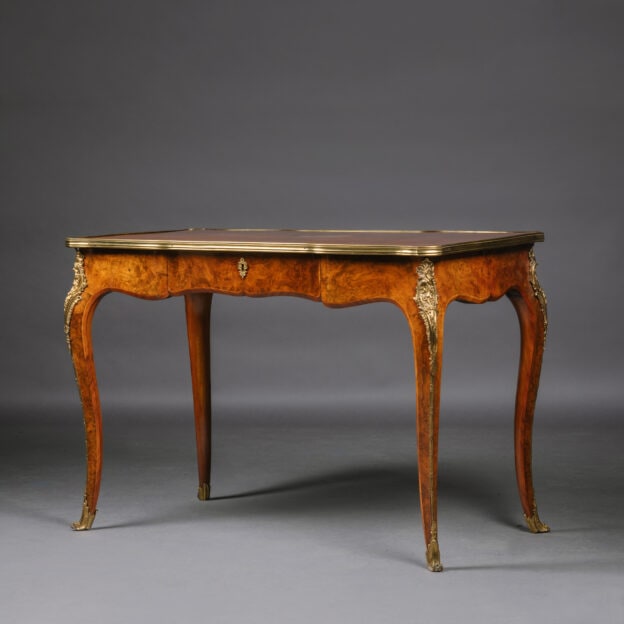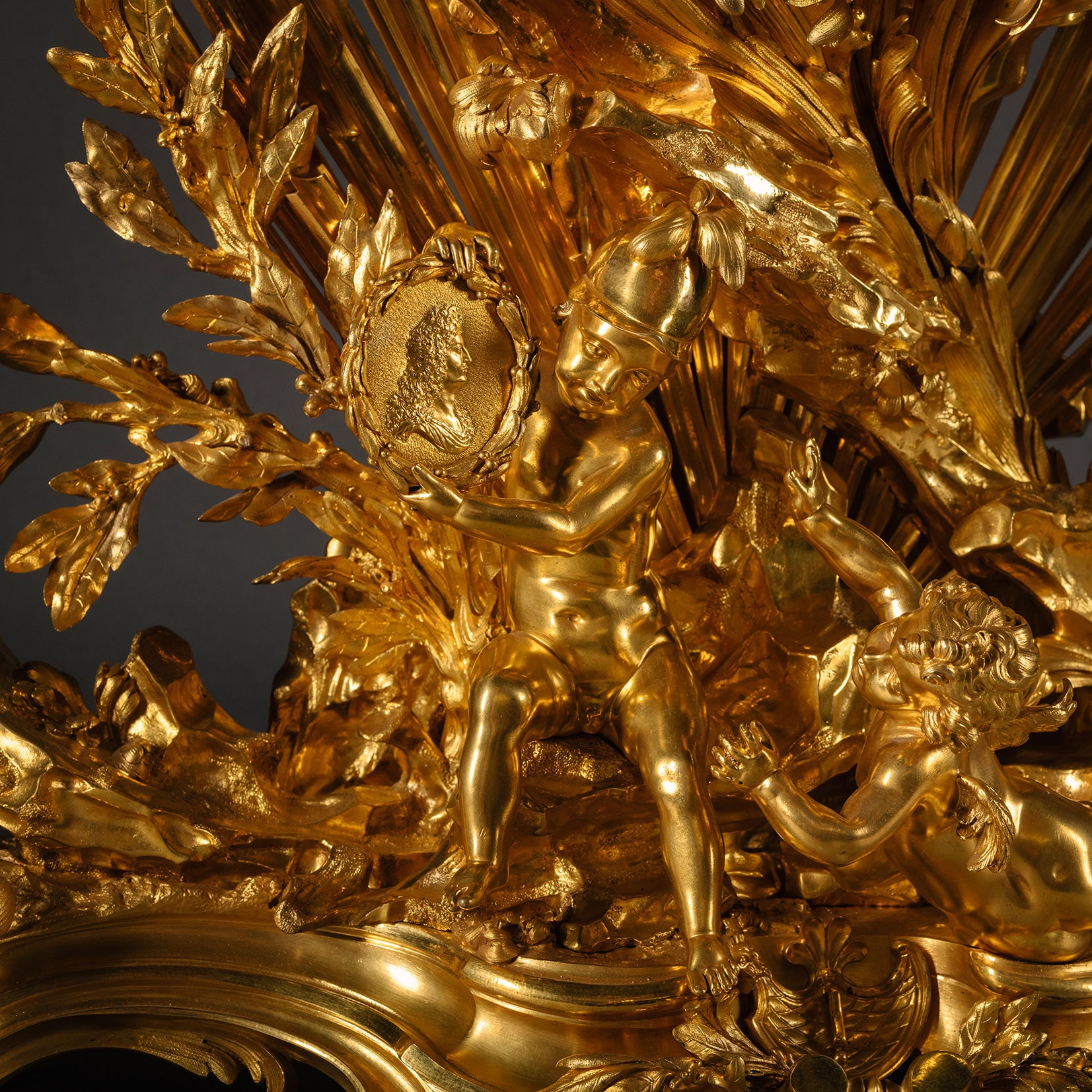Henry Dasson
‘Pendule À La Glorie du Roi’, A Large Louis XV Style Mantle Clock
£84,000
A Large Louis XV Style Gilt-Bronze Mantle Clock by Henry Dasson, Dated 1883, After The Model By Edmé Jean Gallien. Signed 'henry Dasson. 1883'. Surmounted...
Dimensions
Height: 87 cm (35 in)Width: 75 cm (30 in)
Depth: 25 cm (10 in)
Description
A Large Louis XV Style Gilt-Bronze Mantle Clock by Henry Dasson, Dated 1883, After The Model By Edmé Jean Gallien.
Signed ‘henry Dasson. 1883’.
Surmounted by a wreath-bearing putto, above laurel and acanthus branches, the cylindrical case with twin-barrel movement, Brocot escapement and rack striking to bell, above a rockwork base issuing a sunburst, the naturalistic scrolled rocaille foot mounted with two further putti, one with a portrait medallion of Louis XIV.
France, Dated 1883.
This spectacular clock is based on an 18th century model dedicated to the memory of the Sun King, Louis XIV. and as a celebration of the Glory of France. Its full title was ‘La France gouvernée par la sagesse et couronnée par la Victoire qui accorde la protection aux arts’ ” (France governed with wisdom and crowned by the victory which gives protection the the arts).. The original movement was made by Jean Martinot, the casting and possibly the chiselling by Edmé-Jean Gallien, with gilding by Gobert. It was initially placed in Louis XV’s bedroom at the Château de Fontainebleau before being moved to the Château de Compiègne and then to the Château de Versailles, where it is now on view in the cabinet du Conseil (VMB 8706). The clock face emerges from an elaborate foliate support surmounted by a winged putto emblematic of fame and anchored by two additional putti at the base: the first emblematic of the génie of Mars holding the King’s portrait, the second of France leaning forward in admiration.
The model was widely admired in the 19th century, and in addition to examples by Hendry Dasson, an example by Charles Crozatier and Henri Picard is displayed in the grand salon of the Napoleon III apartments at the Louvre, having formerly been on view at Versailles, the Palais des Tuileries and the Préfecture at Strasbourg (OA 5132).
Date
Dated 1883
Origin
France
Medium
Gilt Bronze
Signature
signed and dated 'henry Dasson. 1883'
Henry Dasson (1825-1896) was one of the finest makers of gilt-bronze mounted furniture in the nineteenth century. Unlike other cabinetmakers of this time Dasson started his career as a bronze sculptor, and for this reason one of the characteristics of his work is the great quality of his bronze and more precisely of the chiselling.
With a workshop established in Paris at 106 rue Vieille-du-Temple, he specialised predominantly in the production of Louis XIV, XV and XVI style furniture using the very finest gilt-bronze mounts.
In 1871, he purchased the flourishing business and remaining stock of Charles-Guillaume Winckelsen, who had established a reputation for furniture of the highest quality. Dasson almost certainly inherited the craft of ciseleur from Winckelsen.
At the 1878 and 1889 Paris Expositions Universelles Dasson exhibited a number of pieces in the Louis XV and XVI styles, as well as pieces of his own modified eighteenth-century design. The exhibits in 1878 included a table entirely in gilt-bronze, purchased by Lord Dudley. His copy of the celebrated Bureau du Roi sold at the same exhibition to Lady Ashburton.
Dasson ceased production in 1894, and at this time held a sale of his models, listed in Catalogues of drawings for art bronzes, style furniture and important decoration with rights of reproduction by Henry Dasson et Cie, manufacturer of art bronzes and cabinetmaker as a result of cessation of production..’ The records from this sale show that Paul Sormani, as well as Joseph Emmanuel Zweiner, Maison Millet and Beurdeley acquired certain drawings and models by Dasson.
Jonathan Meyer illustrates a number of exceptional items exhibited by Dasson in 1889 in his book on the Great Exhibitions.
Bibliography:
Mestdagh, Camille & Lécoules, Pierre. L’Ameublement d’art français : 1850-1900, Les Editions de l’Amateur, (Paris), 2010.
Ledoux-Lebard, Denise. Les Ebénistes du XIXeme siècle, Les Editions de l’Amateur, (Paris), 1984; pp. 146 – 151.0
Meyer, Jonathan. ‘Great Exhibitions – London, New York, Paris, Philadelphia, 1851-1900′, Antique Collectors’ Club, (Woodbridge, UK), 2006; p. 269, pls. H7, H8, H10: p. 270, pl, H12.
Tardy, French Clocks the World Over, Part One, p. 279;
H. Ottomeyer and P. Pröschel, Vergoldete Bronzen, Vol. I, p. 130, fig. 2.8.21
P. Verlet, Les Bronzes Dorés Français du XVIIIe Siècle, p. 303, fig. 335, for illustrations of the 18th century model by Gallien.
D. Alcouffe et al., Gilt Bronzes in the Louvre, p. 296-297, for a 19th century model by Charles Crozatier, in Napoléon III’s apartments in the Louvre.

















 Print
Print


